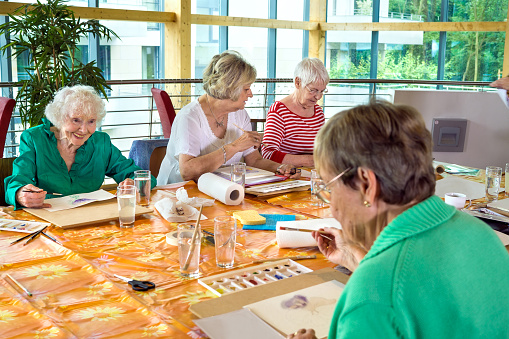Alzheimer’s Disease diminishes a person’s memory and other cognitive functions. It has been discovered however that artistic and creative talent are areas that are left unfazed by this condition. Accordingly, art therapy has been recognized as an effective therapy for Alzheimer’s patients. We are going to provide you with the benefits of art therapy, some tips for participating in artistic projects with your patient or loved one, as well as some project ideas.
Benefits of Art Therapy
Art therapist and author Ruth Abraham lauds “art therapy has been shown to be a powerful tool for people with Alzheimer’s; it helps them to express their feelings when they can no longer do so with words.” Other ways that art can help benefit these patients are listed below.
- It provides a creative outlet, allowing them to release frustrations and express themselves at the same time
- Helps to improve patient’s concentration. It allows the patient to focus on abilities he or she still has instead of lost functioning
- Builds closer relationships between the loved one and the caregiver. Working on art projects together allows the two to bond
- Improves the patient’s behavior. The relaxed calming effect that creating art evokes results in a better mood and better behavior.
Tips for Successful Use of Art Therapy
Four primary tips can help ensure that art/craft therapy is a positive experience for your loved one: keeping it simple, choosing projects that only require a few supplies, limiting group size based on their stage of Alzheimer’s, being flexible, and breaking activities up into easy-to-follow steps.
Complex projects may be overwhelming, so choose something that challenges but does not frustrate your loved one. Having to manipulate a large amount of supplies may be over stimulating for the Alzheimer’s patient, so choosing projects that require limited supplies is important.
Depending on the stage of Alzheimer’s your loved one is in, large group projects may be too much for them to handle. This is especially true for those in the later stages of the disease, who may need to do projects one on one.
It is important to be flexible when working on projects with your loved one. They may not do well with a specific project so you might have to go through a trial and error period, and you may have to adjust the times that you work on these projects to suit them. Breaking projects into easy to follow steps simplifies the process, reducing the patient’s frustration, and makes completing the activity more achievable for him or her.
Project Ideas
Some artistic activities that will allow creative expression without causing unnecessary frustration include:
- Playdough – This allows them to create and exercise and stretch their hands at the same time.
- Sorting buttons by color or size – This can be done individually or as a group activity.
- Scrapbooking – Give them a theme and have them find pictures in magazines and newspapers.
- Water color painting – This allows them to express themselves through pictures, whereas they might not be able to verbally.
- Holiday projects – During the holidays, you can have them do projects centered around festive decorations.
You may also want to check out our games and activities as well.
We hope these ideas prove useful in providing possible artistic outlets for your loved one.
© Copyright 2017 The Wright Stuff, Inc. Articles may only be redistributed in its unedited form. Written permission from The Wright Stuff, Inc. must be obtained to reprint or cite the information contained within this article.





